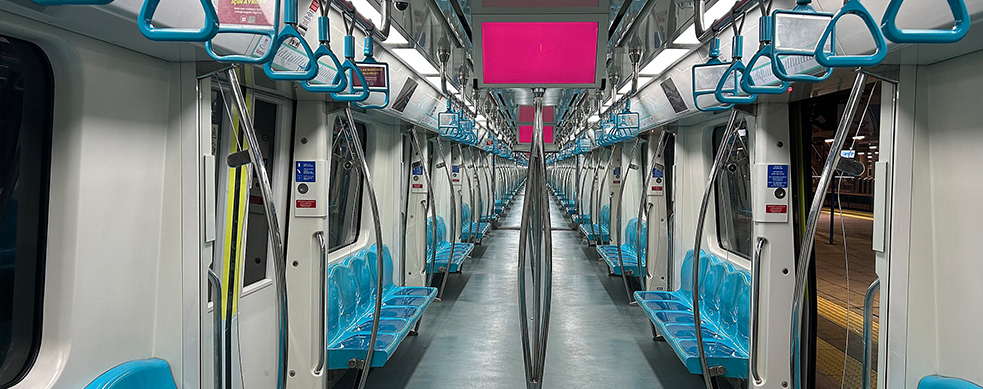
The Importance of Using Ozone in Public Transportation Vehicles
Public transportation vehicles are the backbone of urban transportation. In daily life, millions of people travel by buses, subways, trains and other public transportation vehicles. The health, comfort and safety of people traveling in these vehicles are of great importance in the transportation sector. In this context, improving the indoor air quality of public transportation vehicles not only increases the comfort of passengers, but also is a critical step in preventing health problems. Ozone is an effective solution to achieve this goal. The air purification properties of ozone play an important role in improving the air quality in public transportation vehicles.
What is Ozone?
Ozone (O₃) is a gas consisting of three oxygen atoms. Ozone, which is usually found at high levels in the atmosphere, absorbs the ultraviolet rays of the sun’s rays and protects the earth from harmful radiation. Ozone is also a compound with strong oxidizing properties, and these properties are used in many areas such as air purification, odor removal and microorganism control. Ozone is known for its ability to eliminate polluted air and bad odors.
Air Purifying Properties of Ozone
Since ozone is a strong oxidizing agent, it is very effective against pollutants in the air. Polluted air in the interiors of public transportation vehicles is full of harmful substances such as carbon dioxide, ammonia, nicotine, bad odors, microorganisms and bacteria. The accumulation of these substances can negatively affect the health of passengers.
Ozone oxidizes these pollutants in the air and turns them into harmless compounds. For example, ammonia and other organic substances react with ozone and turn into less harmful compounds. At the same time, ozone kills bacteria and viruses, prevents the proliferation of microorganisms and improves air quality. Thanks to these properties, ozone can be used to increase air quality, especially in closed areas.
Areas of Use of Ozone in Public Transportation Vehicles
The main purpose of using ozone in public transportation vehicles is to improve the air quality in the interiors of the vehicles. Passengers traveling in a clean, fresh and healthy environment increases their comfort and provides a healthy travel experience. The use of ozone in public transportation vehicles provides benefits in several important areas.
Odor Removal:
Public transportation vehicles are used by many passengers throughout the day, and this can cause bad odors to accumulate in the vehicles. These odors can disrupt the comfort of passengers and provide a negative travel experience. Ozone is very effective in eliminating bad odors. Ozone oxidizes the molecules of bad odors in the air and creates a fresh air environment. This feature is very useful in public transportation vehicles such as buses, trains and subways.
Cleaning of Microorganisms and Bacteria:
The presence of many different people in public transportation vehicles can cause the spread of microorganisms and the transmission of diseases. Ozone has the ability to kill bacteria and viruses. Thanks to this feature, ozone prevents the proliferation of microorganisms and viruses in public transportation vehicles, thus reducing the spread of infections. This is a very important advantage, especially in terms of public health.
Air Purification and Pollutant Reduction:
In public transportation vehicles, the ventilation system in the interiors is usually limited, which can lead to the accumulation of pollutants. Ozone oxidizes harmful pollutants in the air and renders them harmless. In this way, the air quality in the interiors of the vehicles is improved. Ozone creates a healthier environment by reducing the levels and concentrations of carbon dioxide, nitrogen oxides, ammonia and other pollutants.
Traps and Cleaning of Cigarette Smoke:
Although smoking is prohibited in public transportation vehicles, sometimes passengers can get on public transportation vehicles with the smell of cigarettes on them or by not paying attention to their personal hygiene. Cigarette smoke and lack of personal hygiene deteriorate air quality both with its smell and with substances that are harmful to health. Ozone improves air quality by effectively eliminating cigarette smoke and other pollutants. This provides a great advantage especially in environments where smoking is prohibited.
Supporting the Ventilation System:
Ozone generators can be integrated into the existing ventilation systems in public transportation vehicles. The ventilation system allows fresh air to enter the vehicle, while ozone generators clean the air inside. This helps to continuously improve the air quality inside the vehicle. In addition, ozone generators can operate with low energy consumption, which increases energy efficiency in public transport vehicles.
Using Ozone During Cleaning Operations:
When cleaning the interior of public transport vehicles, intensive ozone application to public transport vehicles It will destroy bacteria, viruses and microorganisms and create a healthy and comfortable environment.
Health Benefits of Ozone Use
Ozone use in public transportation vehicles directly affects the health of passengers. Ozone kills harmful microorganisms in the air and reduces the risk of infection for passengers. In addition, ozone’s ability to eliminate bad odors increases the comfort of passengers. Traveling in a clean air environment can reduce passengers’ stress levels and improve their general health.
Ozone can also help prevent respiratory diseases by improving air quality. Polluted air can trigger respiratory disorders such as asthma and bronchitis. Ozone reduces the risk of these diseases and provides a healthier environment.
Things to Consider About Ozone Use
Since ozone is a strong oxidizer, it can have negative effects on health if not used correctly. The density and duration of ozone should be adjusted correctly. Otherwise, high ozone levels can lead to headaches, throat irritation, coughing and respiratory problems. Therefore, ozone use should be managed by experts and regularly monitored.
The use of ozone in public transport vehicles is extremely important in terms of improving air quality, eliminating bad odors, cleaning microorganisms and protecting the health of passengers. Ozone can be used in public transport vehicles as an effective air purifier and ensures that passengers travel in a healthy, comfortable and safe environment. However, ozone use should be managed carefully and unnecessary health risks should be avoided. The correct application of ozone technology can provide a revolutionary development in the public transport sector and provide a healthier transportation experience for passengers.
İlker KURAN
Alperen Mühendislik Ltd. Şti.







